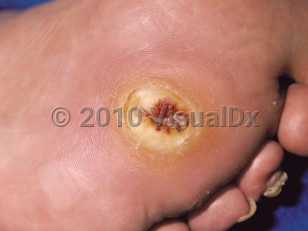Neurogenic ulcer
Alerts and Notices
Important News & Links
Synopsis

Neurogenic ulcers (also known as neuropathic and diabetic ulcers; mal perforans) are ulcerations on the pressure points of the foot caused by repetitive trauma. Neurogenic ulcers are typically found in individuals with peripheral neuropathy, diabetic peripheral neuropathy, anatomic deformities of the foot, Charcot neuroarthropathy, or peripheral artery disease. The pathogenesis is typically due to neuropathy but may be multifactorial (eg, neuropathy and peripheral artery disease). Secondary infection of the ulcer may prevent healing.
Neurogenic ulcers are most commonly seen in individuals with long-standing diabetes; it is one of the most common complications of diabetes mellitus (type 1, type 2) and affects approximately 19%-34% of individuals with diabetes during their lifetime. There is a recurrence rate of 60% in 3 years for individuals with diabetes. Twenty percent of neurogenic ulcer patients with diabetes will require amputation with a 70%, 5-year mortality after amputation. The presence of neurogenic ulcers in diabetic patients increases mortality by 2.5-fold. While the overwhelming majority of neurogenic ulcers occur in individuals with diabetes, other conditions can cause polyneuropathy (eg, alcohol use disorder, arsenic poisoning) or local neuropathy (eg, herpes zoster, Hansen disease) and can also be precipitating factors.
Neurogenic ulcers are difficult to treat, frequently recur, and result in significant morbidity in the form of loss of function and, often, loss of limb.
Neurogenic ulcers are most commonly seen in individuals with long-standing diabetes; it is one of the most common complications of diabetes mellitus (type 1, type 2) and affects approximately 19%-34% of individuals with diabetes during their lifetime. There is a recurrence rate of 60% in 3 years for individuals with diabetes. Twenty percent of neurogenic ulcer patients with diabetes will require amputation with a 70%, 5-year mortality after amputation. The presence of neurogenic ulcers in diabetic patients increases mortality by 2.5-fold. While the overwhelming majority of neurogenic ulcers occur in individuals with diabetes, other conditions can cause polyneuropathy (eg, alcohol use disorder, arsenic poisoning) or local neuropathy (eg, herpes zoster, Hansen disease) and can also be precipitating factors.
Neurogenic ulcers are difficult to treat, frequently recur, and result in significant morbidity in the form of loss of function and, often, loss of limb.
Codes
ICD10CM:
E13.621 – Other specified diabetes mellitus with foot ulcer
L97.509 – Non-pressure chronic ulcer of other part of unspecified foot with unspecified severity
SNOMEDCT:
15074003 – Neurogenic ulcer
E13.621 – Other specified diabetes mellitus with foot ulcer
L97.509 – Non-pressure chronic ulcer of other part of unspecified foot with unspecified severity
SNOMEDCT:
15074003 – Neurogenic ulcer
Look For
Subscription Required
Diagnostic Pearls
Subscription Required
Differential Diagnosis & Pitfalls

To perform a comparison, select diagnoses from the classic differential
Subscription Required
Best Tests
Subscription Required
Management Pearls
Subscription Required
Therapy
Subscription Required
References
Subscription Required
Last Reviewed:10/25/2023
Last Updated:11/29/2023
Last Updated:11/29/2023
 Patient Information for Neurogenic ulcer
Patient Information for Neurogenic ulcer
Premium Feature
VisualDx Patient Handouts
Available in the Elite package
- Improve treatment compliance
- Reduce after-hours questions
- Increase patient engagement and satisfaction
- Written in clear, easy-to-understand language. No confusing jargon.
- Available in English and Spanish
- Print out or email directly to your patient
Upgrade Today


